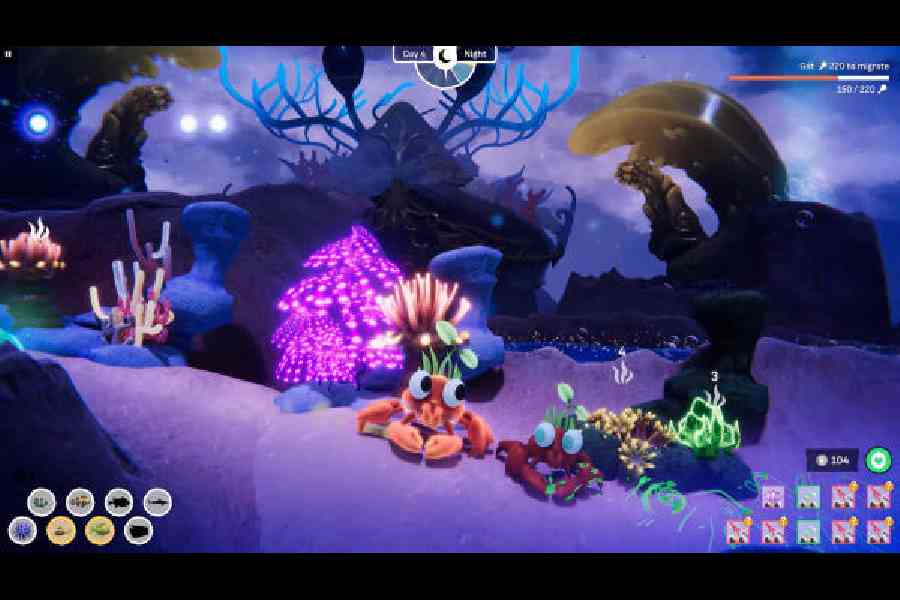In a world of coral reefs, industrious sea creatures and dangerous predators, you are in debt to the eponymous Crab God. The offering begins as a Tamagotchi-style endeavour in which you must oversee round-eyed crablings with anthropomorphised names such as Clawdette. They coo like babies as you hatch them, and then are given jobs to create a diverse aquatic biome.
But there’s deep strategy involved. Five types of crabs are protecting the lair and a precious egg that will evolve into the next crab god. Crablings build, garden and pay homage to the leering crustacean who looms large in the background. It’s all an effort to help the colony thrive.
I was drawn in by the balance needed to secure a thriving, stable ecosystem and details such as the delightful sideways moves of a crabling holding a mallet.
Crab God, by studio Chaos Theory, is part of a genre of climate games that make you cognisant of real-world environmental challenges. It won a Unity for Humanity Award because a healthy chunk of it deals with ocean preservation. It does not bash gamers over the head about the climate crises at hand; Crab God excels by subtly weaving in affecting ideas.
Riven
Riven was the 1997 sequel to the graphically amazing Myst, a science fiction puzzle game full of environmental artwork that you click through to progress.
The Riven remake by Cyan Worlds is just as mind-blowing, with its strange books that are portals to varied worlds. Although it seems you’re alone, you always feel you’re being watched. Haunting, droning music intensifies this feeling as you search for a woman named Catherine and fight to free yourself from these unusual lands.
The primary change is in the gameplay. Players can finally move forward in a 3D environment without clicking through the static screens of another era. It’s a joy to marvel at the sparkling waves of Temple Island as if I were atop some rocky Grecian isle staring into the ocean below.
Because the game is also made for virtual reality, you can turn around and inspect things nearby. Clues can be almost invisible. But they’re everywhere, including on a tree trunk. A burl reveals an eye that opens and shuts. You’ve seen the eye before. But what does it symbolise? Keeping a notebook of clues is a necessity. Riven can be considered a work of enduring popular art — except for one overriding issue.
To move from scene to scene, software must load, and the load times are long. The minutes it took heated up my computer to the point that I thought my graphics card would fail. The culprit was my gear. My three-year-old video card couldn’t take it. I soldiered on, playing a little at a time, decreasing the video fidelity to cool the laptop. Riven still looked impressive, but the distraction lessened its charm. The worry about my overheating computer kept taking me out of the experience.
Rabbids: Legends of the Multiverse
Rabbids could have been an inspiration for Minions. But they’re definitely ruder.
Ubisoft introduced the cute, kooky but rebellious alien rabbits in 2006’s Rayman Raving Rabbids. Called “vicious” and “stupid” by their creator, Michel Ancel, they have evolved to become a squad of fighters in Rabbids: Legends of the Multiverse, a strategic mobile game. Made exclusively for Apple Arcade, this 10-hour gem is available with the monthly subscription fee.
You drag cards representing a wide variety of Rabbids onto the playing field, the first of which is in a medieval town. Adding a few cards lets loose Rabbids with arrows, swords and magic. Defeat a drunken monk named Brother Gothmilk and you will own his card, which can heal wounds by serving you milk.
The bug-eyed and gaptoothed Rabbids march dutifully forward through each level, readying to battle with absurd but useful powers, including those of the trudging Bell Ringer. A riff on Victor Hugo’s Quasimodo, he wields a heavy chain to slap enemies. Once he builds up power, he can spin those metal links to catch foes who are too close. It can be stunningly fun stuff. Your lead hero, a bit bigger than the rest, carries what looks like a Polaroid camera, except it shoots rays at enemies once they come close.
When you win, you receive coins that help you increase Rabbid strength. But too often you’re matched with a foe so formidable that there’s no way to win. Matching systems are supposed to populate somewhat equally. Here, I often felt small and powerless.
One more complaint: when many Rabbids were on the screen together, my iPhone 12 warmed up considerably. Apparently, it can also be hard for games to beat the heat.
nytns











